Few truly believe the rat race is life in all its entirety. Most feel there’s something more, beyond the concrete horizons. And although this something more is often obscured by smartphone notifications, mortgage repayments and the daily grind, it’s never truly forgotten. It’s there, a constant presence, acting as a private motivation, a flickering inner flame.
We all, now and then, need a break from our switched-on, plugged-in Twenty-first Century existence. Our happiness depends on taking the opportunities we can to unplug, switch off, and go offline. That’s the philosophy of Offline Campers out of South Oz, one which I’m sure will resonate with many readers.
Their hard-floor, rear-fold Raker, the end result of over 25,000km of testing culminating in a Simpson Desert crossing, seems to ask: if you’re leaving the big city and going out bush, why not ride off in a golden chariot? Equipped with top tier off-grid and offroad gadgetry, and decked out luxuriously for ultimate comfort, the Raker is ready to take you and your fam offline for lengths of time you’d barely dare to dream of.
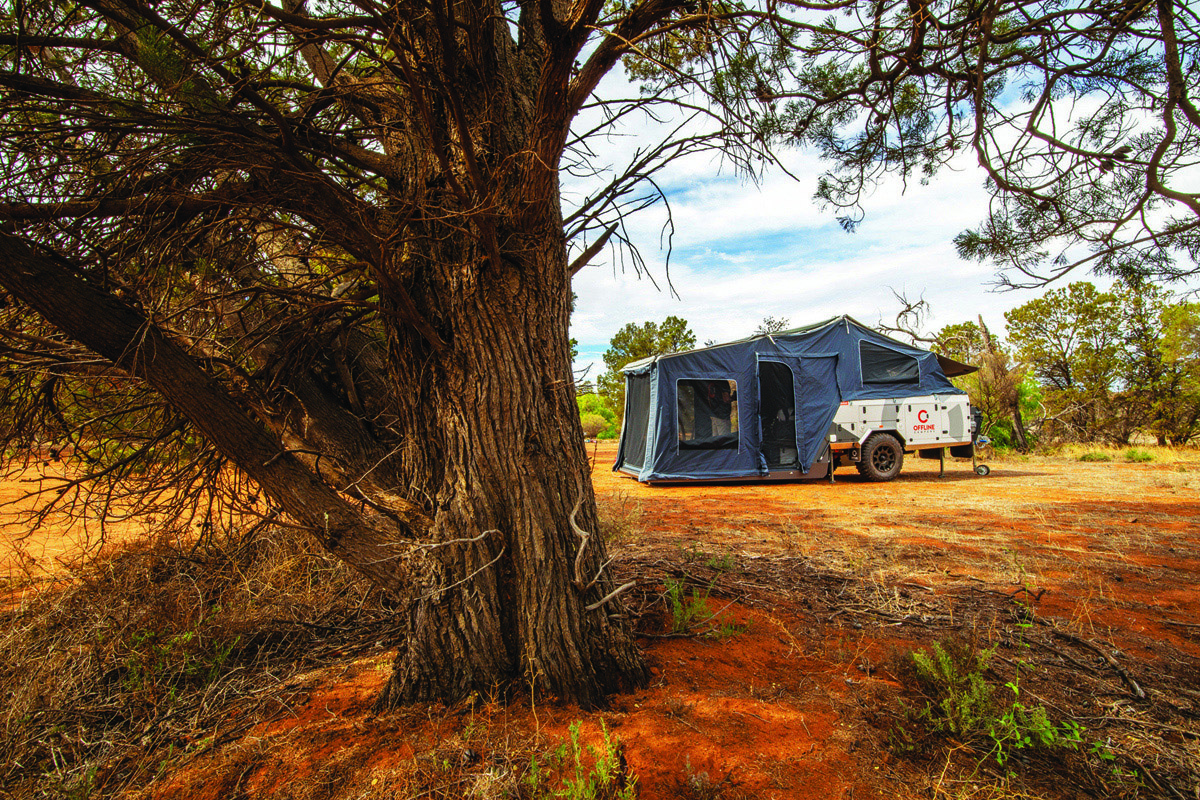


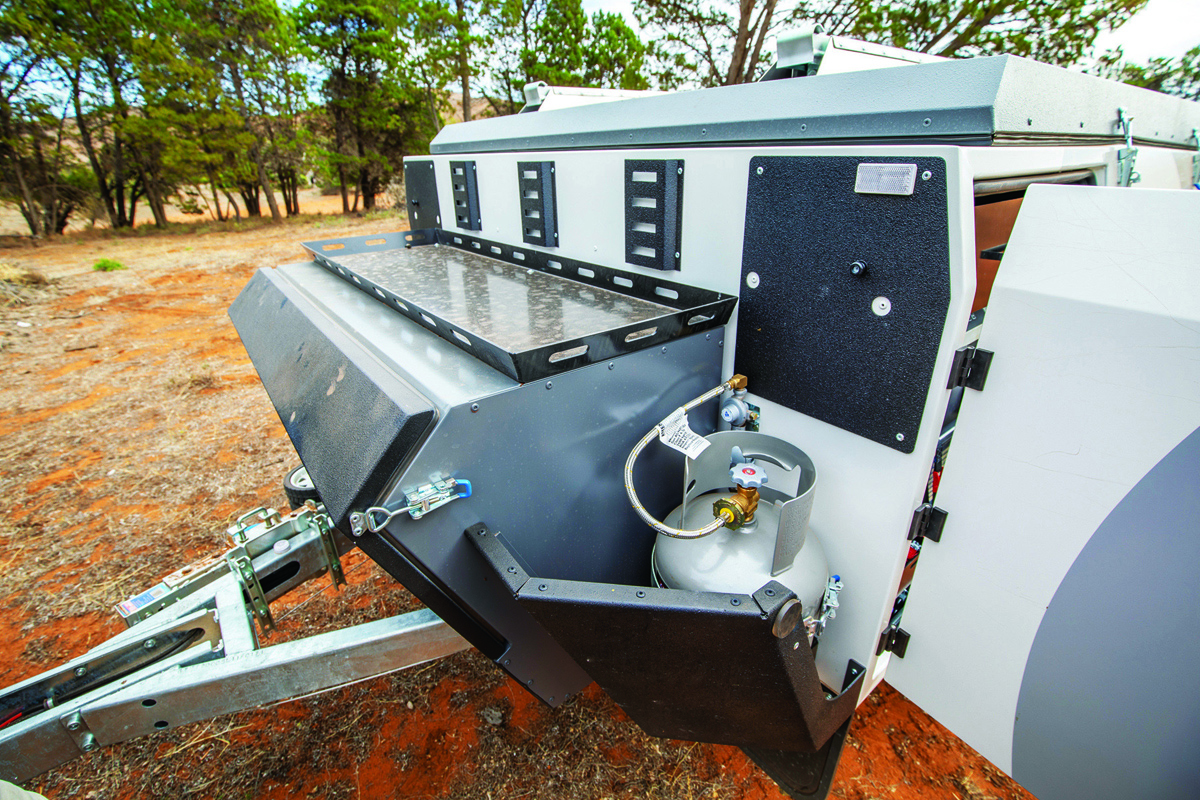

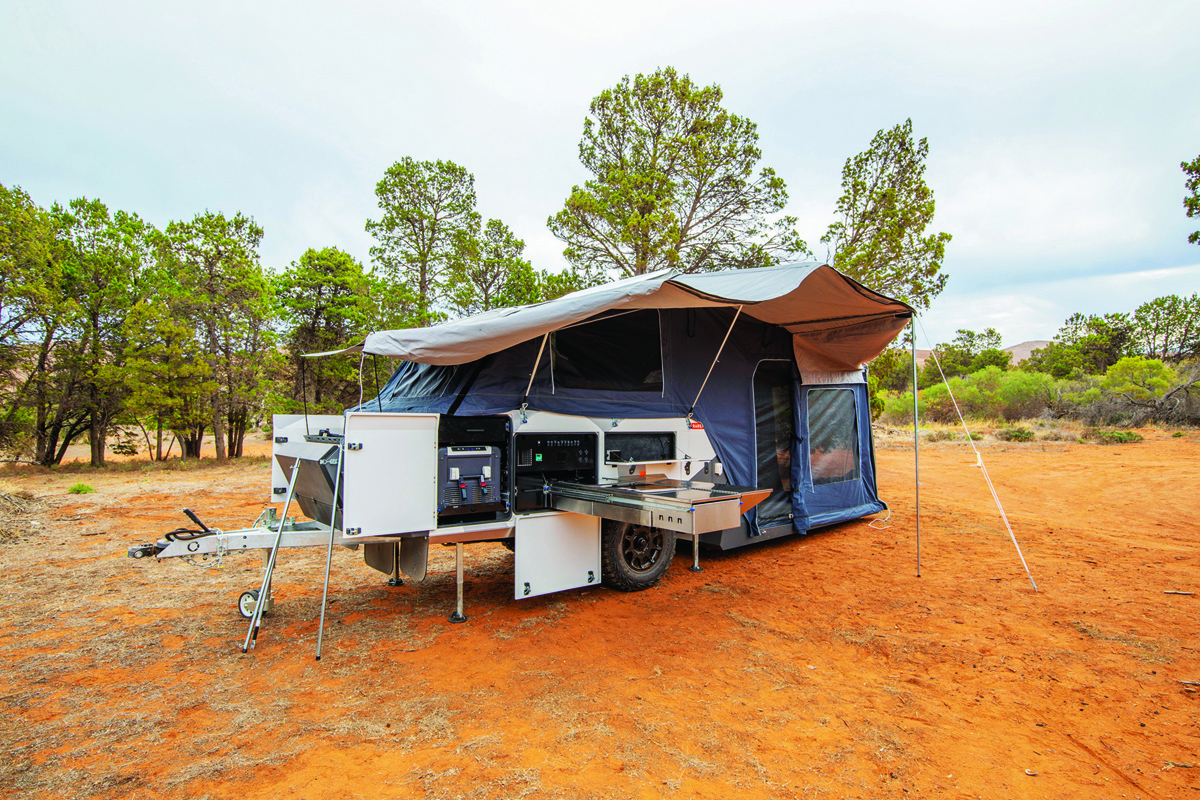
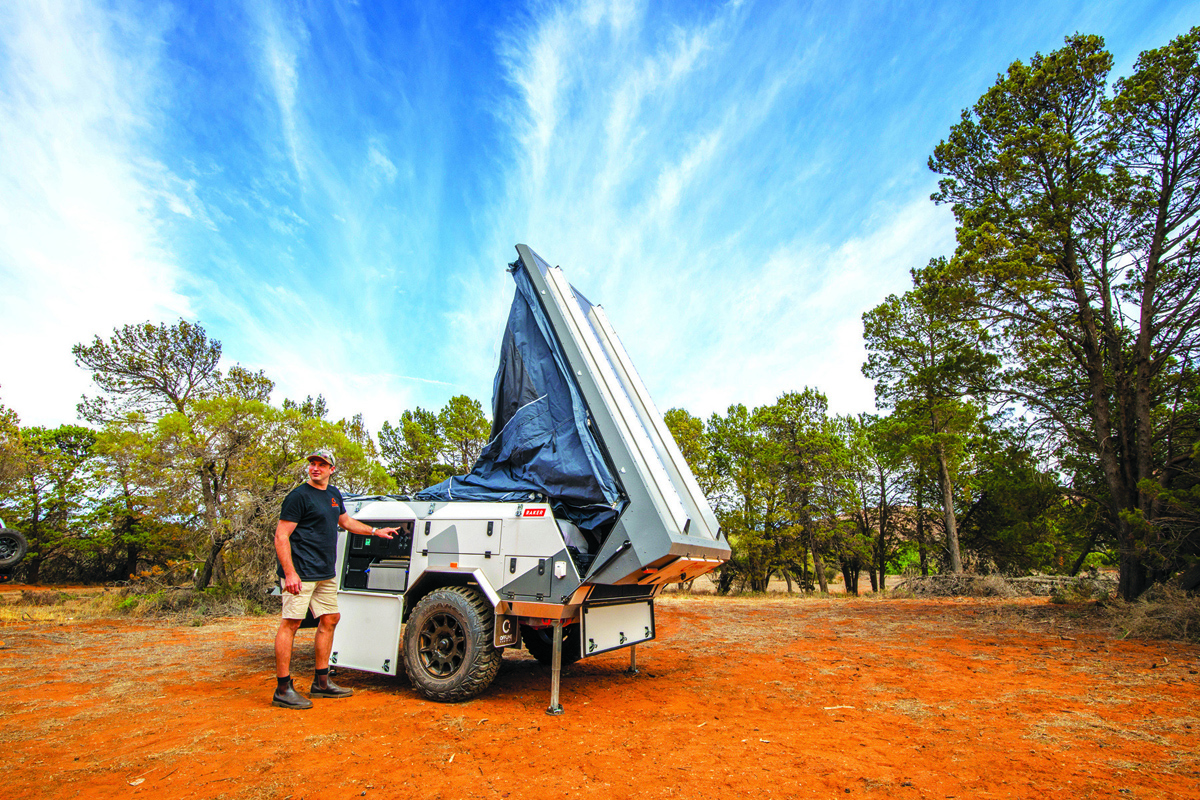
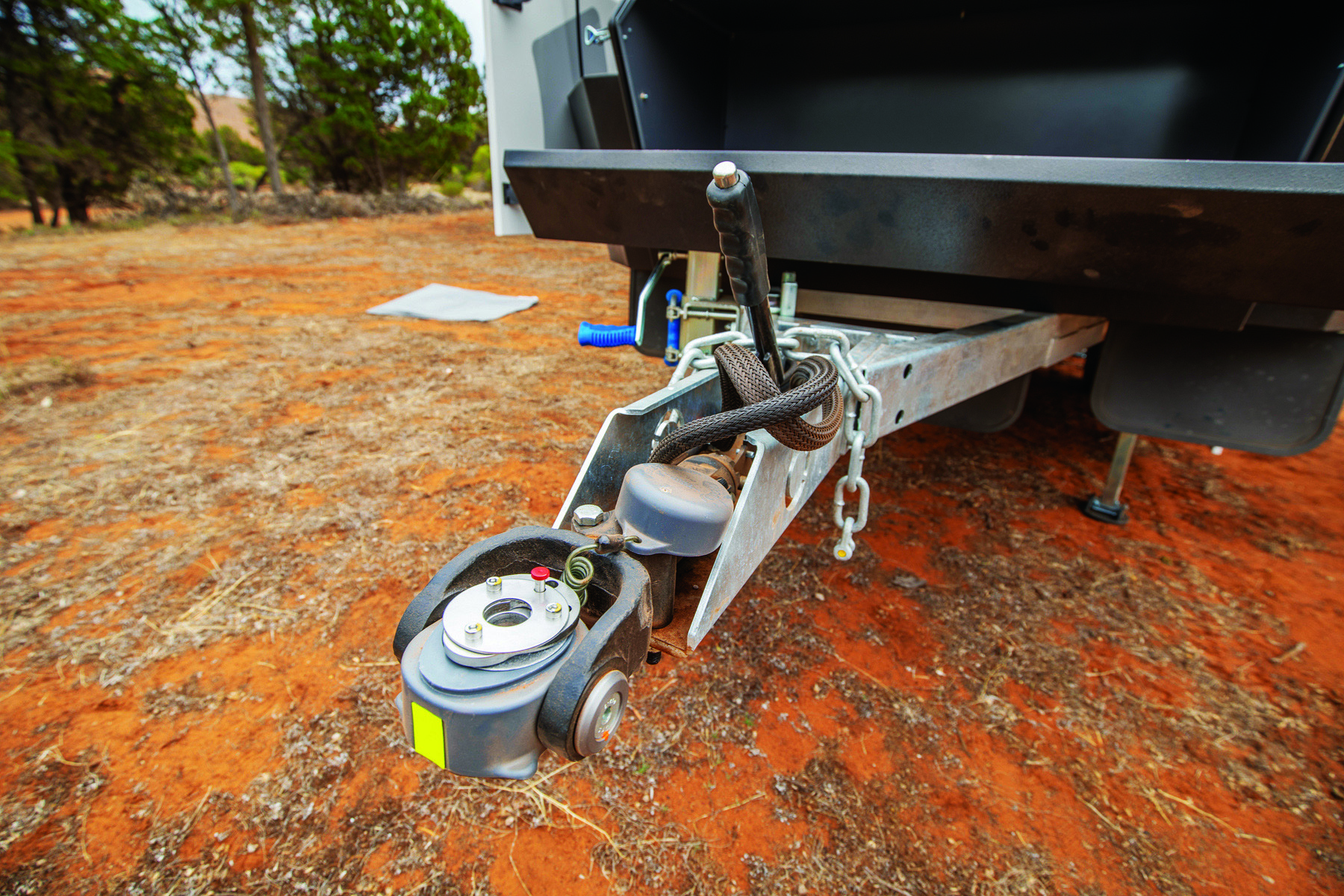
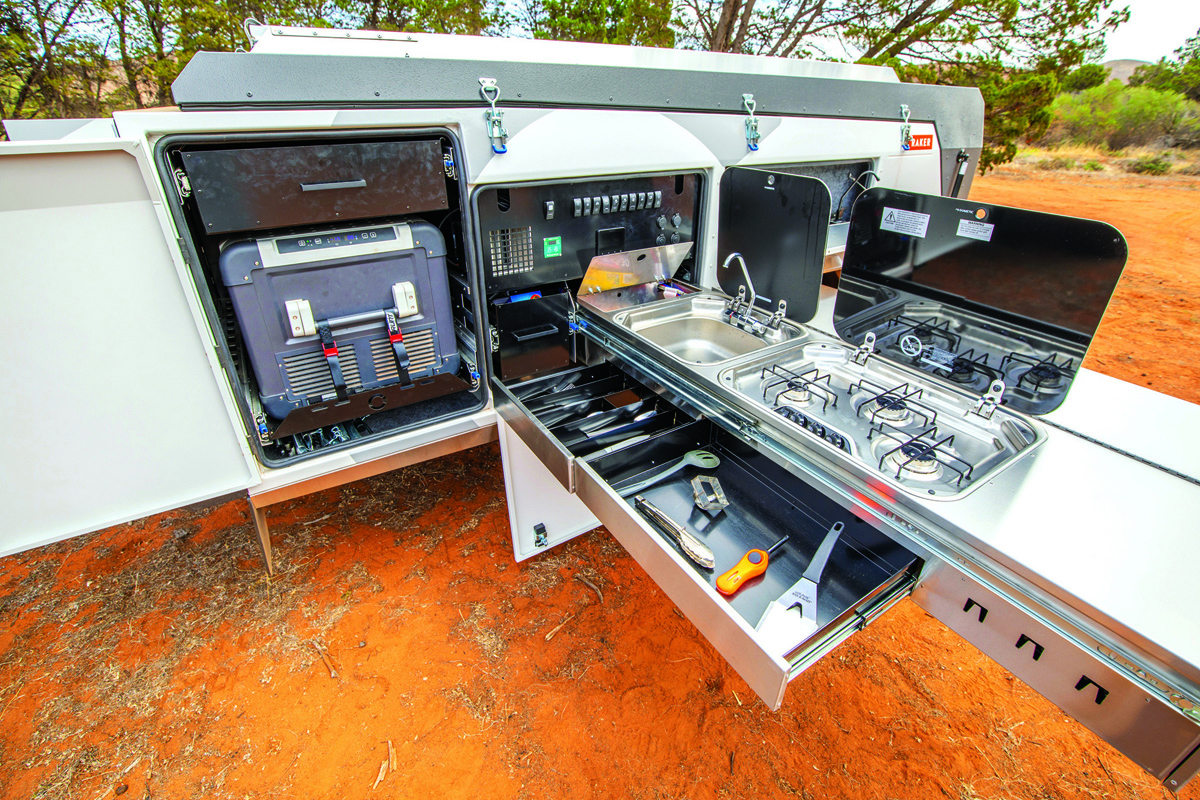
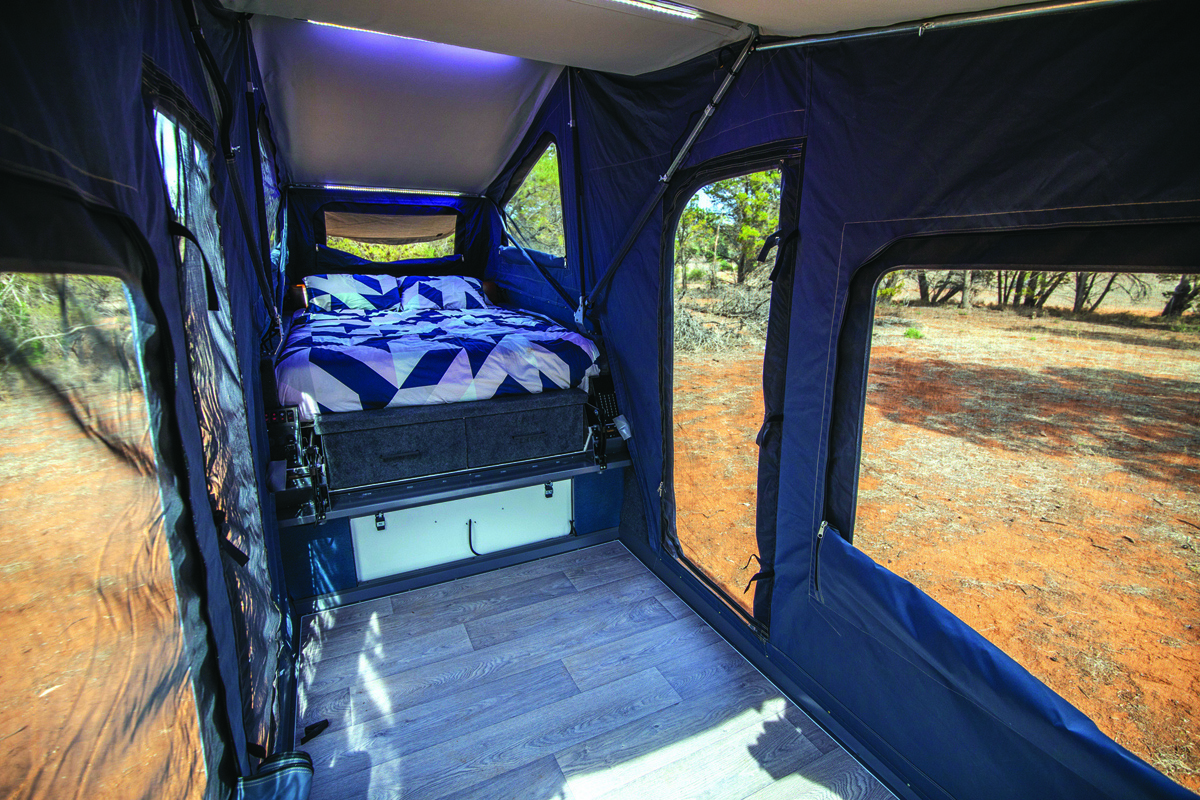
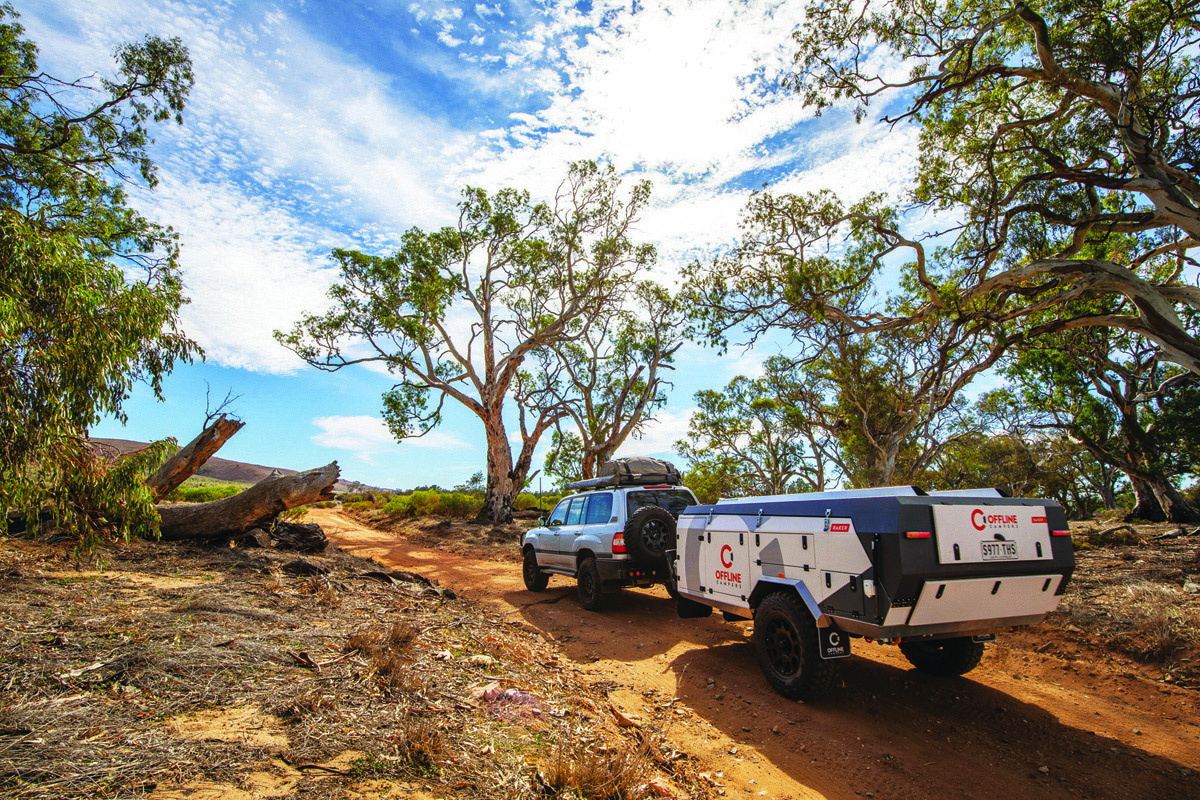
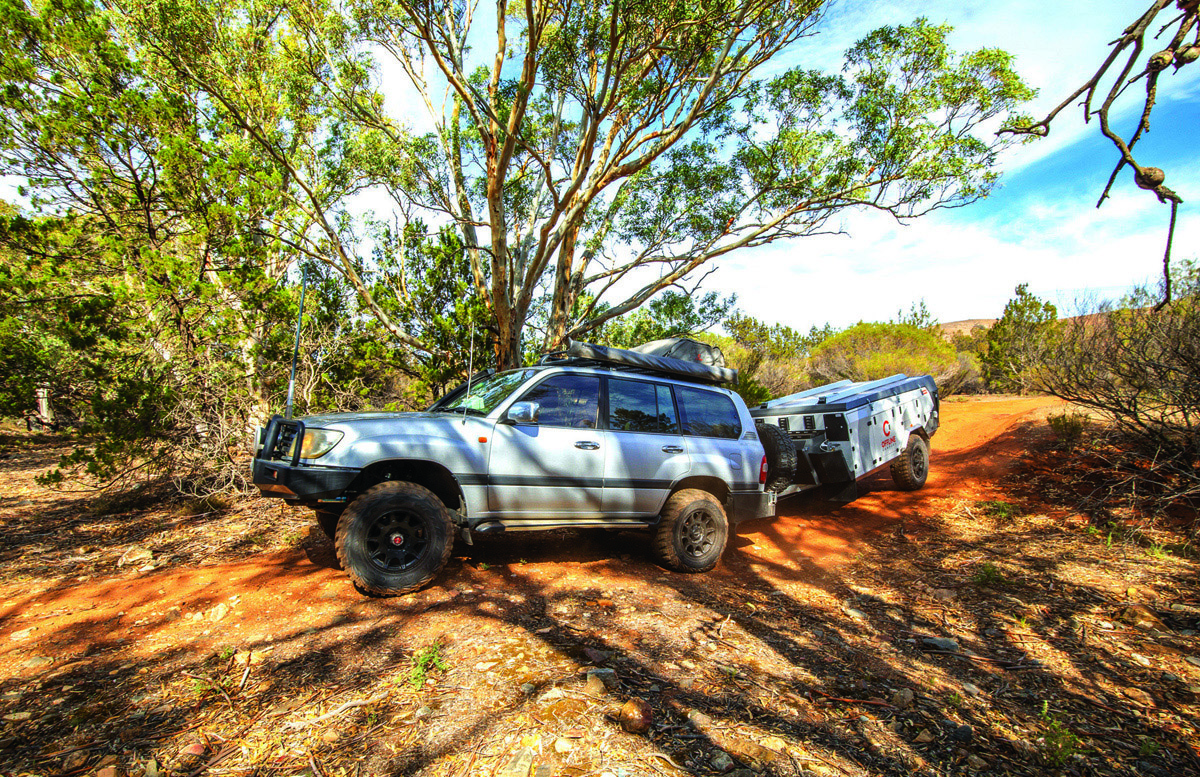
UP FOR ANYTHING
Offline match your camper’s tyres (up to 35”) and suspension offset to your car’s, plus they extend the drawbar if necessary, to ensure you can open your vehicle’s boot when hitched.
The Cruisemaster DO35 hitch grants limber dexterity in all three planes, while the Cruisemaster XT suspension makes the ride soft as a baby’s bottom. An optional airbag system supplants coil springs to grant the smoothest possible ride, adjustability of ride height and levelling out on uneven campsites. Cruisemaster G35 shocks come default, but you can elect to have Fox remote reservoir shocks, which are particularly good at retaining their dampening properties through sustained corrugations.
Elsewhere underneath, the Raker is neat and tidy with no breakable plastic fittings, nor vulnerable wiring or waterlines. The positioning of the spare tyre underneath is unorthodox but places weight low, and — unlike other, more common positionings — does not complicate day-to-day functionality. Plus, with the Raker, you’ll be able to use your car’s spare or spares first.
The Raker travels short for a rear-fold at 4.67m, while the moderate width and height ensure better than normal visibility. The relatively light Tare of 1200kg won’t yoke your 4WD, but you’ll notice weight more when taking advantage of the 1900kg ATM.
A TMC bilge blower, linked to your headlights or manually operated, draws air from behind the front toolbox through a filter to increase internal air pressure, preventing dust ingress when driving along bone-dry unsealed roads.
The drawbar and hot-dip galvanised chassis are of 100 x 50 x 3mm high-grade RHS steel laser cut in Adelaide. Hi-lift jack points come standard and chassis-mounted rear recovery points can be optioned on. The body is composed of marine-grade aluminium and stainless steel.
In the name of maintaining sleek appearance, chip-prone areas are stainless steel, the stoneguard is coated in raptor liner, and its side-panels and upper plates can be unbolted and resprayed.
AUTOMATIC CONVENIENCE
Option-tickers can use Cruisemaster airbag suspension to level out their camper on uneven ground. Long stabiliser legs underneath the hard floor mean the ground behind the camper body can be uneven, too.
With the ARK XO 750 and four stabilisers down, you unclip three latches along both sides of the fold, opening a door at the rear as you pass. This door must be hanging for the camper to open without causing damage, but with the door closed a switch is depressed, disabling the opening mechanism so no mistakes are possible.
On either side of the camper, you hold a button to bring over the hard floor using two actuators and two gas struts. Such automation is superbly convenient and abolishes all heavy hauling, awkward acrobatics or winch winding. If automation fails, you can disconnect the actuators and fold it manually.
The fold complete, and the hard floor stabilisers lowered if necessary, you then enter and unstrap hanging poles from the main framework, then lift a U-shaped pole (hinged in the far corners) from the hard floor until it props the canvas on the far side. You take the hanging poles and lock them to this U-shaped pole, extending all poles until canvas is taut. One final pole clips in horizontally to prop up the canvas roof and prevent rain from pooling.
Outside, you insert spring steel poles into upright slots on the stoneguard and hook them into the eyelets of the awning over the bedhead window.
The automation and captive poles help shorten this basic set-up to about three and a half minutes.
OUTDOOR LIVING SPACE
To set the annexe up, you retrieve the poles from under the fridge slide. You clip two into connections at the tent’s peaks, join supporting poles to the latches on the camper body and link them with the upper poles, and extend them to length so the upper poles are horizontal.
These two poles (and the third that’ll go out in a minute) feature integrated KORR strip lighting powered from plug-in points near the tent’s peaks. With them out, you can cook under lights without setting up the awning, which allows you to abruptly gorge the hungry Horaces in the 6pm winter darkness, then speedily pack up and drive on into the night. Lights can be switched between white or bug-deterring orange.
The annexe roof travels folded over the roof of the camper, meaning no space is wasted storing it and no fiddling with high zips is required. You release it on the far side then bring it over and guide its sleeves over the horizontal poles. At this point you insert the third leg near the entry door and support it with a standing pole and guy rope.
The annexe can be deployed three ways. The first (‘quick mode’) involves now folding the loose corners into triangles and Velcro-ing them to the awning’s underside. The second has these corners unfolded and held up with standing poles. The third involves zipping on an optional 900mm extension and is probably your best bet in slanting rain. This space can then be enclosed with optional walls and heated with the optional external Webasto diesel heater fan.
A PORTABLE RESTAURANT
A door hangs down to allow the stainless-steel kitchen to slide out. A shelf folds off the slide and supports itself against its side, offering 145cm by 35cm of prep space and revealing the three-burner Dometic cooktop and sink. Neither gas nor water need to be connected at point of use. There’s three hanging tabs for bin bags or tea towels.
A drawer extends off the slide’s end; two drawers extend out the front (at the cook), one with a cutlery tray; and an additional receptacle nestles by the sink. To the left of the slide-out pulls out a pantry the width of the camper.
The next panel over houses a huge fridge, a CFX 95L as seen. Above there’s a drawer half the width of the camper. The panel to the kitchen’s right drops down and holds at 90 degrees to extend working space and allow for quick clearing of the kitchen slide; within, there’s two power points to run a suitable appliance or appliances (such as a blender, egg-beater or certain coffee machines), and a drinking water tap.
The long pantry slide and fridge slide extend out into the space where the cook stands, meaning you are best off fetching all ingredients, then closing these slides to cook. That’s a trade-off for the compactness and doesn’t detract from the comfort and capacity of this quality kitchen.
NO NEED TO CALL IT EARLY
As standard, the Raker features two 105Ah AGM batteries, but as we saw it, it featured 240Ah in lithium. Given the potential of this camper, it seems wise to take the longevity, increased useable charge, and faster recharging that lithium affords.
The batteries are charged via a 20A (or optional 40A) DC to DC Enerdrive charger by your alternator and the optional solar panels, and a 40A AC to DC Enerdrive charger when you have access to mains or a generator. So, whether you’re out bush or at a caravan park, you’ll have charging options, and you needn’t buy a separate AC to DC charger for charging when the camper is garaged.
You can option one or two integrated 175W solar panels onto the roof; on the overcast day of review, these were collectively pumping in eight amps. These panels only cop sunlight when the camper is set up with the awning in position, which most, myself included, would see as a worthwhile sacrifice for having the awning permanently attached.
USB and cigarette 12V outlets dot the camper inside and out. The review model also featured a 2600W Enerdrive inverter, powering two sets of power points (one inside, one outside). With an inverter of that size, you can run a coffee machine, toaster or hairdryer and, with lithium batteries, not have to monitor your usage too closely.
If you’re plugged into mains power, the power points will be powered by mains, not your inverter (good news for battery health). There are also two Anderson plug outlets, one for charging the car’s auxiliary battery and a 50A one for charging an item like a chainsaw.
Chargers and the inverter travel on the back wall of the tunnel boot and are best accessed from inside after set-up. Batteries are stored under the bed, above the axle.
Everything can be monitored and controlled from a panel above the kitchen, which features a Simarine battery monitor. This displays power in and out, water tank levels (as percentages, not fractions), and trailer and water temperature (so you know when to shower or do the dishes).
Two stainless steel tanks with separate fillers, one 125L, one 75L, lug life-giving liquid. The larger is intended for bore or creek water and is plumbed to the kitchen and ensuite; the smaller is intended for drinking water and is plumbed to its own tap, protected behind a door. A valve allows you to elect where water is coming from and drain valves allow you to drain water at the end of your holiday.
Both sides of the front toolbox there’s a holder for a 4kg gas bottle. The bottle on the passengers’ side is plumbed.
ROOM FOR ALL CAMPING EQUIPMENT
There’s a large toolbox over the drawbar. You wouldn’t want to overload this, but could store a few jerry cans here and some light bulky items (eg. life jackets). On top, there’s a flat tray with raised edges, ideal for tying down firewood. Three metal installations across the camper’s face provide additional tie-down points.
The fridge slide has room for a 95L CFX fridge or similar; a drawer half the camper’s width opens out above it. The door that reveals the slide secures against the stoneguard with a magnet.
Next to the kitchen slide, a long, narrow drawer pulls out the full width of the camper. The kitchen slide itself features various compartments (as described earlier).
At the rear, a panel lifts upward to grant access to the 280mm of available space above the mattress (where you are likely to stow the kid’s stretchers or cots). At the front, there’s room for additional items, such as dirty clothes for quick access when you drop into a country laundromat.
Below, another door drops downwards to reveal two carpeted drawers which extend out 1210mm and measure 615mm wide, 280mm deep. You can position dividers down their length to compartmentalise this space as you wish.
Behind a panel on the drivers’ side, there’s a dedicated cradle for a table, compensating for the absence of an in-built dinette. In the final compartment, there’s room for a Weber or porta potti. Above this, a drawer slides out halfway.
Impressively, no storage compartments are closed in during set-up, nor cut off when the camper is packed away.
HOME AWAY FROM HOME
Entry is gained via two side doors and one on the rear. Inside, you stand on a 32mm composite floor covered in lino of your choice. As with any hard floor, you can’t feel rocks or sticks under your bare feet and have a guaranteed level surface.
Measuring approximately 2.95m by 1.66m, the floorspace would suit a table and chairs, or stretchers or cots for little ones (two or three depending on orientation). The drawers at the body’s rear pull out into this space.
KORR LED lighting strips are attached to the three main overhead poles and operated via switches at the bed’s toe, where you’ll also find various 12V outlets plus the two interior 240V power points. Wiring to the lights is run inconspicuously through the hollow tube poles.
The north-south queen-sized bed is gained via an in-built step up and can be enclosed with an optional privacy curtain. A $500 allowance for the mattress is standard, but higher quality offerings can be built into the quote. As seen, it was inner-sprung, 300mm thick and as comfortable as at home, which will massively improve your experience during long trips. Sleeves on poles and carpet over metal surfaces ensure you don’t accidentally touch anything unpleasantly chilly at night.
A padded leather bedhead allows you to sit up and watch a movie or read a book comfortably. On either side, there’s a press-operated reading light and a double USB outlet.
Behind the bedhead, three carpeted panels lift out to reveal the upper tunnel boot drawers, seen from above. Think of it as a bedside drawer for books, tissues or other bedtime items. When in place, these panels create a flat shelf ideal for resting your laptop or other items on.
An optional Webasto diesel heater warms the tent from a fan at the foot of the bed. You can option on air conditioning (at the cost of drawer space) to cool off when you have access to mains power or a generator. The interior should be pleasant even without one, courtesy of the eight windows/doors. On these, canvas overhangs the mesh slightly to prevent water ingress through zips.
A rectangular ensuite connects over the hard-floor’s drivers’ side door, held up with two diagonal poles and a spreader bar. With the Webasto system, there’s no need to position portable elements; you just heat your water and attach the trigger-operated showerhead.
The ensuite is only accessible internally, so there’ll be no wet mud inside nor late-night nudie runs. As is common with camper showers, water drains onto the surrounding floor, so rinsing off may not be suitable at all campsites.
IS IT THE ONE FOR YOU?
The Raker starts at around $55,000, but ticking the options takes the price towards $70,000. Inevitably, a figure like this will be out of some people’s price range, but the quality, luxury and capability are there to justify it for those with the dosh. You can catch Offline at the rescheduled Brisbane and Melbourne shows, and serious buyers can arrange a private viewing in South Australia.
Rarely do you find a camper featuring tech on this scale. I can’t help but be reminded of Patriot or BRS. Given the rugged capability, you may expect a drop-off in luxury and family-friendliness, but there isn’t one. Instead, the Raker dominates here, too. Youngsters can sleep, play and begrudgingly shampoo their hair, just as mum and dad can sip wine sitting up in the comfy bed with the heater on. This is camping, but not as you know it. Yet.
SPECS
Offline Campers Raker
TRAILER
Tare 1200kg
ATM 1900kg
Payload 700kg
Ball weight 160kg
Suspension Cruisemaster XT suspension with G35 shock absorbers. Optional airbag suspension upgrade and Fox remote reservoir shock absorber upgrade
Brakes 12” electric
Coupling Cruisemaster DO35
Chassis/Drawbar 100 x 50 x 3mm high-grade RHS steel, chassis hot-dip galvanised
Body Marine-grade aluminium and stainless steel
Wheel/tyre Matched to towing vehicle up to 35” inch tyres
Style Hard-floor rear-fold
DIMENSIONS
Travel 1550m (H) x 1800mm (W) x 4670mm (L)
Floor length 2950mm (L) x 1660mm (W)
Annexe (set-up) 6.5m x 2.5m
ACCESSORIES
Water 125L tank for kitchen and ensuite, optional 75L tank for drinking water from separate tap, optional Webasto diesel heater for hot water at sink and ensuite shower outlet
Gas 2 x 4kg bottles, one plumbed
Kitchen Stainless steel slide-out with two or three burner and sink, optional custom barbecue drawer (coming soon), 250L storage within arms’ reach of kitchen, 95L CFX fridge
Battery 2 x 105Ah AGM battery standard, can be upgraded to lithium. 20A Enerdrive DC to DC charger standard (40A optional) and Enerdrive 40A AC to DC charger standard. Optional 400 to 2600W Enerdrive inverter. Simarine battery monitoring system.
PRICE
The Raker starts from around $55,000 and the price increases with options. Precise options and costings are available on request.
CONTACT
Offline Campers
Email sales@offlinecampers.com.au
Phone 0422 350 110
Web offlinecampers.com.au




